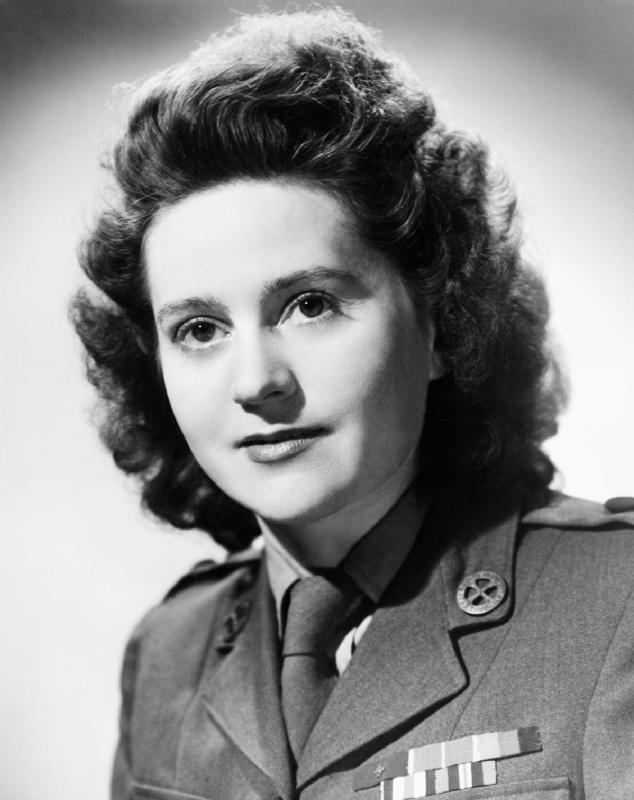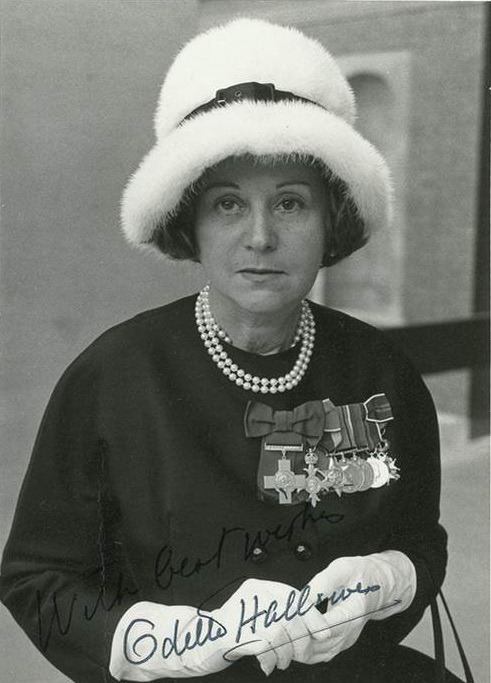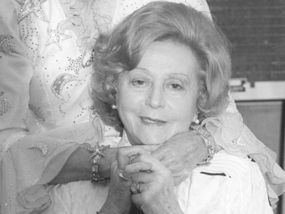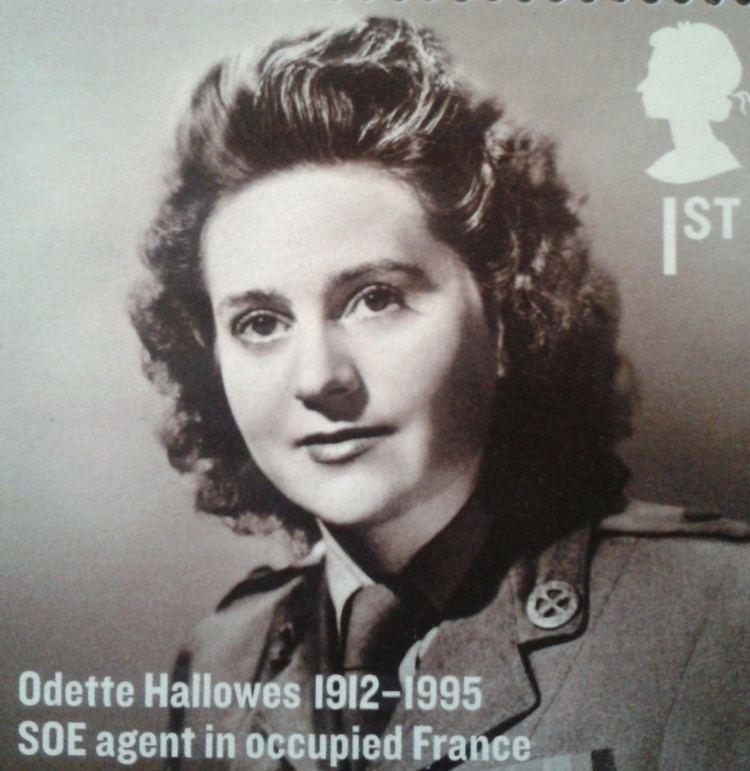Nickname(s) Agent Spindle, Lise Name Odette Hallowes Battles/wars Second World War | Years of service 1942–1945 Battles and wars World War II | |
 | ||
Awards George CrossMember of the Order of the British EmpireChevalier de la Legion d'honneur (France) Similar People Peter Churchill, Violette Szabo, Nancy Wake, Virginia McKenna | ||
Woman Of The Year - London (1969)
Odette Sansom Hallowes (28 April 1912 – 13 March 1995), also known as Odette Sansom and Odette Churchill, was an Allied intelligence officer during the Second World War.
Contents
- Woman Of The Year London 1969
- Odette A Student Short Film
- Early years
- Recruited by SOE
- Service in France
- Fresnes Prison
- Ravensbruck concentration camp
- Survival methods
- After the war
- Legacy
- Related cultural works
- References

Her wartime exploits and endurance of a brutal interrogation and imprisonment, which were chronicled in books and a motion picture, made her one of the most celebrated members of the Special Operations Executive, the British sabotage and espionage organisation, and one of the few to survive Nazi imprisonment.

She was the first woman to be awarded both the George Cross, and to be appointed a Chevalier de la Légion d'honneur.

Odette A Student Short Film
Early years

She was born Odette Marie Céline Brailly in Amiens, France, the daughter of Gaston Brailly, a bank manager, who was killed at Verdun shortly before the Armistice in 1918 and was posthumously awarded the Croix de Guerre and Médaille militaire for heroism. She had one brother. As a child she contracted serious illnesses which blinded her for three and a half years, as well as polio, which resulted in her being bedridden for months. She had a convent education and was considered difficult, perhaps because of her illnesses.
She met an Englishman, Roy Sansom, in Boulogne and married him in 1931, moving with him to Britain. The couple had three daughters: Françoise, Lily and Marianne. Mr Sansom joined the army at the beginning of the Second World War, and Odette Samson and the children moved to Somerset for their safety.
Recruited by SOE
In the spring of 1942, the Admiralty appealed for postcards or family photographs taken on the French coastline for possible war use. Hearing the broadcast, Samson wrote that she had photographs taken around Boulogne, but she mistakenly sent her letter to the War Office instead of the Admiralty. That brought her to the attention of Colonel Maurice Buckmaster's Special Operations Executive.
As cover for her secret work, Sansom was enrolled in the First Aid Nursing Yeomanry (FANY), which supplied SOE with support personnel. She left her three daughters in a convent school, and was trained to be sent into Nazi-occupied France to work with the French Resistance.
Originally Sansom was considered too temperamental and stubborn by SOE, with an evaluation stating "She is impulsive and hasty in her judgments and has not quite the clarity of mind which is desirable in subversive activity. She seems to have little experience of the outside world. She is excitable and temperamental, although she has a certain determination." However, the evaluation noted "her patriotism and keenness to do something for France." Buckmaster allowed her training to continue regardless. A bad fall during training ruled out parachute entry into France.
Service in France
Sansom made a landing on a beach near Cassis on the night of 2 November 1942, and made contact with Captain Peter Churchill, who headed SPINDLE, an SOE network based in Cannes. Her code name was "Lise." Sansom's initial objective was to contact the French Resistance on the French Riviera, and then move to Auxerre in Burgundy to establish a safe house for other agents.
At the time of her arrival in France, the SPINDLE network was beset by internal strife between the principal agent, André Girard, and his assistant and with the network's radio operator, Adolphe Rabinovitch. A list of 200 potential supporters, lost by a Girard courier, was obtained by the Germans. With Sansom stranded in Cannes, Churchill obtained Buckmaster's permission to scrap her original mission and act as his courier. Sansom, posing as "Madame Odette Metayer," was required to find food and lodging for Rabinovitch, who was in France illegally and had no ration card, and also to tend to air drops that were sometimes carelessly placed in dangerous areas. Her work brought her initially to Marseilles, then considered a dangerous town because of its infiltration by German agents. Sansom was shocked by the lax attitude toward security by her French supporters. Sansom grew close to Churchill and to Rabinovitch, whom she liked and trusted. She later recalled that she had suspicions concerning members of the SPINDLE network, but declined to identify who she suspected.
In 1943, Churchill's operation in France was infiltrated by Hugo Bleicher, an Abwehr counterintelligence officer, using the list of names lost by Girard's courier. Bleicher posed as "Colonel Henri," a German officer who opposed Hitler. Bleicher arrested Sansom and Churchill at the Hôtel de la Poste in Saint-Jorioz on 16 April 1943; they were then sent to Fresnes Prison.
Fresnes Prison
At Fresnes, Sansom was interrogated by the Gestapo fourteen times. She was subjected to torture. Her back was scorched with a red-hot poker and all of her toenails were pulled out. She refused to disclose the whereabouts of Rabinovitch and another British agent, stuck to her fabricated cover story that Churchill was the nephew of Prime Minister Winston Churchill, that she was his wife, and that he knew nothing of her activities. The hope was that in this way their treatment would be mitigated. The British had calculated that if the Germans thought she was related to the British Prime Minister, they would want to keep her alive as a possible bargaining tool.
Sansom succeeded in diverting attention from Churchill, who was subject to only two interrogations, and protected the identities of the two officers, whose locations were known only to her. While imprisoned, Bleicher occasionally appeared and sought to invite her to travel with him to Paris to attend concerts and dine in restaurants, to persuade her to talk. Sansom rejected the overtures.
She was condemned to death on two counts in June 1943, to which she responded, "Then you will have to make up your mind on what count I am to be executed, because I can only die once." Infuriated, Bleicher sent her to Ravensbrück concentration camp.
Ravensbruck concentration camp
In Ravensbruck Sansom was kept in a punishment block cell, on a starvation diet, and could hear other prisoners being beaten.
After the Allied landings in the south of France in August 1944, on orders from Berlin, all food was withdrawn for a week, all light was removed from Sansom's cell, and the heat was turned up. Despite a report by the camp doctor that she would not survive such conditions for more than a few weeks, after being found unconscious in her cell she was placed in solitary confinement. Her conditions only improved in December 1944, when she was moved to a ground floor cell. The cell was located near the crematorium and would be covered with burned hair from the cremations. At one point toward the end of the war, she witnessed an instance of cannibalism of a dead inmate by starving prisoners.
When the Allies were only a few miles from Ravensbrück, the camp commandant Fritz Suhren took Sansom and drove to an American base to surrender. He hoped that her supposed connections to Churchill might allow him to negotiate his way out of execution.
Churchill survived the war but Rabinovitch was executed by the Gestapo in 1944.
Survival methods
Sansom was aided in her endurance in prison by her early blindness and paralysis, and by the example of her grandfather, who "did not accept weakness very easily." She also accepted in advance that she might be captured by the Germans. She adopted an attitude of defiance, and found that this resulted in a degree of respect by her captors and helped her survive the imprisonment mentally.
Sansom said she believed she was "not brave, not courageous, but just make up my mind about certain things." She recalled in a post-war interview that while everyone has a breaking point, her feeling was that if she could "survive the next minute without breaking up, that is another minute of life. And if I can think that way instead of thinking what is going to happen in a half-hour's time," Because of her past illnesses she knew "I was able to accept this, and survive it." By accepting death, she felt that "they would not win anything. They'll have a dead body, useless to them. They won't have me. I won't let them have me." She described it as a "kind of bargaining."
The Germans generally found persons of the prisoners' own nationality to carry out the torture, she later recalled, so that one "could not say they were tortured by the Germans." Her torture was carried out by a "very good-looking young Frenchman" who she believed was mentally ill.
After the war
Sansom testified against the prison guards charged with war crimes at the 1946 Hamburg Ravensbrück Trials, which resulted in Suhren's execution in 1950. Roy and Odette's marriage was dissolved in 1946 and she married Peter Churchill in 1947.
In 1951, her home was burgled and the George Cross stolen. After an appeal by her mother, it was returned with a note saying: "You, Madame, appear to be a dear old lady. God bless you and your children. I thank you for having faith in me. I am not all that bad — it's just circumstances. Your little dog really loves me. I gave him a nice pat and left him a piece of meat — out of fridge. Sincerely yours, A Bad Egg." In 1955, she co-founded the annual Women of the Year Lunch with Tony Lothian and Lady Georgina Coleridge (journalist and daughter of the Marquess of Tweeddale).
She was divorced from Churchill in 1956 and married Geoffrey Hallowes in the same year. Hallowes, a former SOE officer, outlived her and died in 2006.
Legacy
Sansom, known as Odette Churchill after her marriage, gained considerable fame after the publication of a 1949 biography and a film on her war work and prison ordeal in 1950. She became what one biographer described as a "celebrated heroine on both sides of the Channel." However, her story was beset by controversy. Some officials did not believe her story and cast doubt upon her integrity.
She was appointed a Member of the Order of the British Empire and was the first of three Second World War First Aid Nursing Yeomanry members to be awarded the George Cross (gazetted 20 August 1946). She remains the only woman to have received the George Cross whilst alive, all other female awards to date being posthumous. She was also appointed a Chevalier de la Légion d'honneur for her work with the French Resistance.
Documents disclosed long after the war indicate that her superiors had to fight for Samson's George Cross, because she was unable to prove that she had been tortured by the Nazis and that she had not betrayed her fellow agents. The medal was awarded after medical records and eyewitness testimony supported her case.
Her wartime record was the subject of a 1950 film, Odette, in which the title role was played by Anna Neagle and Trevor Howard played Churchill. Buckmaster played himself in the film, and Samson, then known as Odette Churchill, wrote a personal message that appeared at the end of the film, which was well received. Odette Churchill had opposed making the film in Hollywood, for fear that the film would be fictionalised.
She served as a technical advisor on a film on her fellow SOE agent Violette Szabo, Carve Her Name with Pride.
On 23 February 2012, the Royal Mail released a postage stamp featuring Hallowes as part of its "Britons of Distinction" series.
